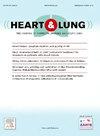U-shaped relationship between weight-adjusted waist index and acute exacerbation of chronic obstructive pulmonary disease in critically ill patients
IF 2.6
4区 医学
Q2 CARDIAC & CARDIOVASCULAR SYSTEMS
引用次数: 0
Abstract
Background
The relationship between obesity and acute exacerbation of chronic obstructive pulmonary disease (AECOPD) has long been a topic of interest, and the newly introduced weight-adjusted waist circumference index (WWI) has better stability in differentiating between visceral fat and muscle mass. However, the relationship between WWI and AECOPD is unclear.
Objective
To investigate the potential relationship between WWI and AECOPD in critically ill patients.
Methods
A total of 986 participants with COPD were included in the present study. The relationship between WWI and AECOPD was explored using logistic regression, subgroup analyses, smoothed curve fitting, and threshold effect analysis models.
Results
As a continuous variable, the risk of AECOPD increased by 23.0 % for each unit increase in WWI. When WWI was used as a categorical variable, the risk of AECOPD increased by 62 % at the fourth quartile of WWI compared with the first quartile. In the adjusted model, potential nonlinear relationships were analyzed by smoothed curve fitting and saturated threshold effects, and a U-shaped relationship between WWI and risk of AECOPD was found, with an inflection point of 9.77. Before the inflection point, WWI was negatively associated with AECOPD; after the inflection point, they were positively associated. In the subgroup analyses, the relationship between WWI and AECOPD risk remained stable after adjustment for all covariates considered.
Conclusion
There is a U-shaped relationship between WWI and AECOPD, with both lower and higher levels of WWI increasing the risk of disease progression in patients with AECOPD.
体重调整腰指数与慢性阻塞性肺疾病危重患者急性加重的u型关系
肥胖与慢性阻塞性肺疾病急性加重期(AECOPD)之间的关系一直是人们关注的话题,新引入的体重调节腰围指数(WWI)在区分内脏脂肪和肌肉质量方面具有更好的稳定性。然而,第一次世界大战与AECOPD之间的关系尚不清楚。目的探讨一战与危重患者AECOPD的潜在关系。方法本研究共纳入986例COPD患者。采用logistic回归、亚组分析、平滑曲线拟合和阈值效应分析模型探讨了第一次世界大战与AECOPD的关系。结果作为一个连续变量,WWI每增加一个单位,AECOPD的风险增加23.0%。当第一次世界大战作为分类变量时,与第一次世界大战的第四个四分位数相比,AECOPD的风险增加了62%。在调整后的模型中,通过平滑曲线拟合和饱和阈值效应分析潜在的非线性关系,发现一战与AECOPD风险呈u型关系,拐点为9.77。拐点前,WWI与AECOPD呈负相关;在拐点之后,两者呈正相关。在亚组分析中,在考虑所有协变量后,第一次世界大战与AECOPD风险之间的关系保持稳定。结论WWI与AECOPD之间呈u型关系,低水平和高水平WWI均可增加AECOPD患者疾病进展的风险。
本文章由计算机程序翻译,如有差异,请以英文原文为准。
求助全文
约1分钟内获得全文
求助全文
来源期刊

Heart & Lung
医学-呼吸系统
CiteScore
4.60
自引率
3.60%
发文量
184
审稿时长
35 days
期刊介绍:
Heart & Lung: The Journal of Cardiopulmonary and Acute Care, the official publication of The American Association of Heart Failure Nurses, presents original, peer-reviewed articles on techniques, advances, investigations, and observations related to the care of patients with acute and critical illness and patients with chronic cardiac or pulmonary disorders.
The Journal''s acute care articles focus on the care of hospitalized patients, including those in the critical and acute care settings. Because most patients who are hospitalized in acute and critical care settings have chronic conditions, we are also interested in the chronically critically ill, the care of patients with chronic cardiopulmonary disorders, their rehabilitation, and disease prevention. The Journal''s heart failure articles focus on all aspects of the care of patients with this condition. Manuscripts that are relevant to populations across the human lifespan are welcome.
 求助内容:
求助内容: 应助结果提醒方式:
应助结果提醒方式:


